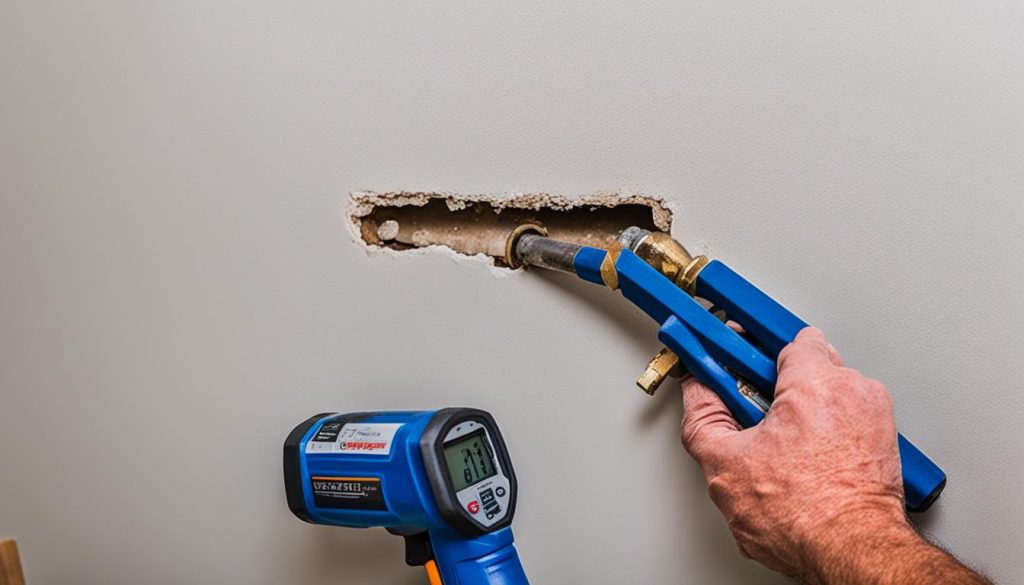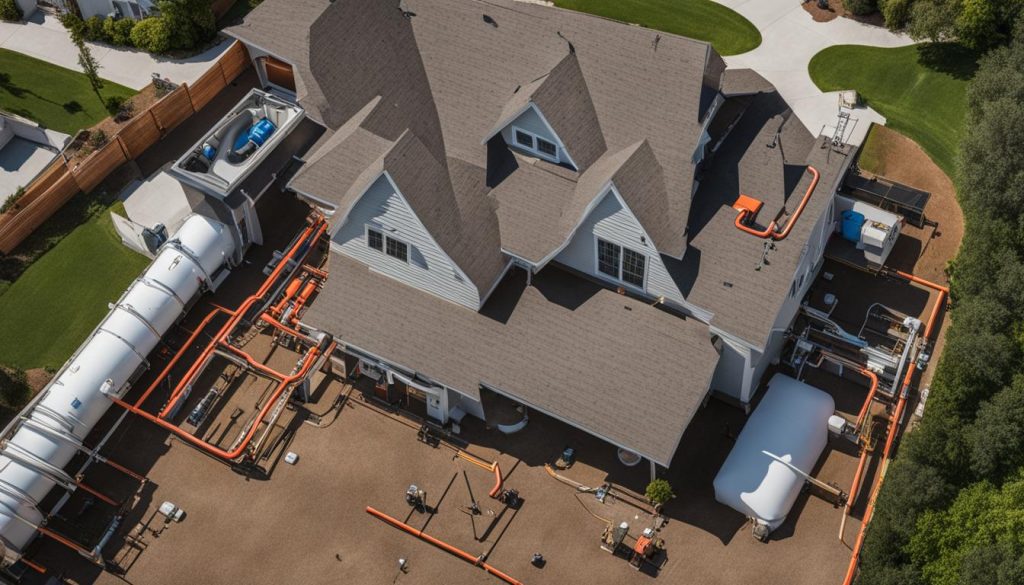Poly B Plumbing Concerns & Solutions Guide
Did you know that polybutylene plumbing, known as poly B plumbing, was commonly used in homes built from the 1970s to the early 1990s? However, it has since been found to be prone to leaks and failures, causing homeowners a great deal of concern.
Key Takeaways:
- Poly B plumbing was commonly used in homes built between the 1970s and early 1990s.
- Poly B plumbing is prone to leaks and failures, causing concerns for homeowners.
- This article provides insights into the concerns associated with poly B plumbing and offers solutions for addressing them.
- Signs of poly B plumbing issues include water stains, low water pressure, and unexplained increases in water bills.
- While temporary measures can extend the life of poly B pipes, complete replacement is often the best solution.
- Insurance considerations should be taken into account when dealing with poly B plumbing.
- When purchasing a home with poly B plumbing, it is important to plan for replacement or negotiate with the seller.
- Trusting poly B plumbing experts will ensure efficient and effective solutions for your plumbing needs.
Signs of Poly B Plumbing Issues
One of the key concerns with poly B plumbing is that damage often occurs from the inside, making it difficult to detect visible signs of deterioration. However, there are some common indicators that can hint at potential problems with your poly B plumbing system:
- Water stains: Look for discolored patches or streaks on walls, ceilings, or floors. These can be signs of leaks behind the surface.
- Low water pressure: If your water flow feels weak or inconsistent, it could be due to blockages or deterioration within the poly B pipes.
- Unexplained increases in water bills: If your water usage hasn’t changed significantly, but you’re seeing a sudden rise in your bills, it could be a result of hidden leaks in your poly B plumbing system.
- Leaks behind walls or under floors: Any visible signs of water damage, such as dampness, mold, or warped flooring, could indicate leaks in the hidden areas of your plumbing system.
If you notice any of these signs, it may be time to consider poly B piping replacement or seek professional poly B plumbing services. Ignoring these issues can lead to further damage and costly repairs in the future.
| Signs of Poly B Plumbing Issues | Potential Causes |
|---|---|
| Water Stains | Leaking pipes behind walls or ceilings |
| Low Water Pressure | Deterioration or blockages in poly B pipes |
| Unexplained Increases in Water Bills | Hidden leaks in the plumbing system |
| Leaks Behind Walls or Under Floors | Undetected leaks compromising structural integrity |
Extending the Life of Poly B Pipes
While it is generally recommended to replace the entire poly B plumbing system, there are some measures you can take to maintain and extend the life of your existing pipes. By following these steps, you can minimize the risk of leaks and prolong the longevity of your poly B plumbing.
Replace Plastic Fittings
One of the first steps towards maintaining poly B plumbing is to replace any plastic fittings with copper or brass fittings. Plastic fittings are more prone to failure, so upgrading to more durable materials can help prevent potential issues in the future.
Avoid Over-Crimping
Over-crimping the metal bands that hold the poly B pipes in place can lead to hairline fractures. To prevent this, make sure to avoid applying excessive pressure during the crimping process. It’s important to handle the installation with care to prevent any damage that could compromise the integrity of the pipes.
Lower Water Pressure
Reducing the water pressure in your poly B plumbing system can help minimize the stress on the pipes. Lower pressure means less strain on the fittings and joints, reducing the likelihood of leaks or bursts. This simple adjustment can significantly extend the lifespan of your poly B pipes.
Reduce Chlorine Content
High chlorine levels in the water can accelerate the deterioration of poly B pipes. Consider installing a water treatment system or using chlorine-reducing filters to lower the chlorine content. This will help slow down the degradation process and contribute to the longevity of your plumbing system.
Adjust Hot Water Tank Temperature
The temperature of your hot water tank can also impact the lifespan of your poly B pipes. Set the temperature to a moderate level that isn’t too high, as excessive heat can put stress on the pipes. By maintaining a comfortable yet safe temperature, you can minimize the risk of premature pipe failure.
It’s important to note that these measures are temporary solutions and won’t eliminate the possibility of future issues. Eventually, the entire poly B plumbing system will likely need to be replaced. Experts in poly B plumbing repairs and maintenance can provide guidance and advice tailored to your specific situation, ensuring the best outcome for your home’s plumbing needs.
Insurance Considerations for Poly B Plumbing
Insurers are often concerned about homes with poly B plumbing due to the potential for significant water damage caused by leaks and ruptures. If your home was built during the period when poly B plumbing was commonly used, insurance companies may inquire about the type of plumbing you have. Some insurers may refuse to provide coverage or impose higher premiums or water damage deductibles for homes with poly B plumbing.
If you already have insurance and experience a water loss due to poly B plumbing, you may face increased premiums or non-renewal of your policy. To ensure transparency, it is important to disclose the presence of poly B plumbing when seeking insurance. Discuss any concerns with a poly B plumbing specialist or company to better understand your options.
Replacing Poly B Plumbing
Due to the inherent risks and potential for future problems associated with poly B plumbing, replacing the entire system is often the best solution. Re-piping your home with a more reliable material, such as PEX or copper, can provide long-term peace of mind and eliminate the risk of leaks behind walls.
The cost of poly B plumbing replacement varies depending on factors such as the size of the property, the extent of plumbing throughout the home, and the replacement material. On average, homeowners can expect to invest between $3,000 and $8,000 for a complete re-piping project. While this upfront cost may seem significant, it is an investment in the safety and value of your home.
When it comes to replacing poly B plumbing, it is crucial to consult with poly b plumbing experts who have the necessary experience and expertise in handling this specific type of plumbing. They will ensure that the replacement is done efficiently, effectively, and in compliance with all relevant building codes. By working with professionals, you can have confidence in the quality of the work and the longevity of your new plumbing system.
Purchasing a Home with Poly B Plumbing
If you are considering buying a home with poly B plumbing, it is important to assess the situation and plan accordingly. Hiring a qualified plumber to inspect the plumbing system and provide an estimate for replacement is a crucial first step. This will give you a clear understanding of the condition of the poly B pipes and help you make an informed decision.
You can use the information from the inspection report to negotiate a lower purchase price for the home. By highlighting the need for poly B pipe replacement, you can present a strong case for reducing the asking price to account for the future expenses associated with replacing the plumbing system.
Alternatively, you can require the seller to replace the poly B plumbing system before the sale is finalized. This ensures that you won’t have to deal with the additional costs or hassle of replacing the pipes yourself and provides peace of mind knowing that the home’s plumbing will be in good condition.
If you do plan to replace the poly B plumbing system yourself, it is crucial to factor in the cost of materials and labor. Additionally, make sure to check with insurance providers to ensure that you can secure coverage for the home during the transition period.
Benefits of Addressing Poly B Plumbing Issues Before Purchasing
Buying a home with poly B plumbing should not automatically disqualify a property from consideration. However, it is important to thoroughly understand the implications of a poly B plumbing system and take the necessary steps to address any issues before finalizing the purchase.
- Ensures the safety and integrity of the home’s plumbing system.
- Prevents potential leaks, water damage, and costly repairs in the future.
- Helps secure insurance coverage without high premiums or exclusions.
- Increases the overall value and marketability of the property.
- Provides peace of mind and avoids the inconvenience of dealing with plumbing issues soon after moving in.
By being proactive and addressing poly B plumbing issues before purchasing a home, you can avoid potential headaches and ensure a smooth transition into your new property. Remember, it’s always better to address plumbing concerns upfront rather than dealing with the consequences down the line.
Poly B Plumbing Experts & Solutions
When it comes to addressing poly B plumbing concerns, it is essential to trust the expertise of professionals. Look for reputable poly B plumbing companies or specialists with experience in handling this specific type of plumbing. They can provide guidance, advice, and reliable solutions tailored to your unique situation.
Whether you require repairs, replacements, or general maintenance, consulting with poly B plumbing experts will ensure that the job is done efficiently, effectively, and in compliance with all relevant building codes. Your home is your biggest investment, so invest in the expertise of poly B plumbing professionals to secure the longevity and safety of your plumbing system.
- Investing Wisely: How Windows & Doors in Boost Property Value and Financial Health - April 24, 2025
- The Financial Impact of Personal Injuries: Why Legal Help Matters for Business Owners - April 16, 2025
- The Hidden Financial Costs of Domestic Assault: What Business Owners Need to Know - April 16, 2025














